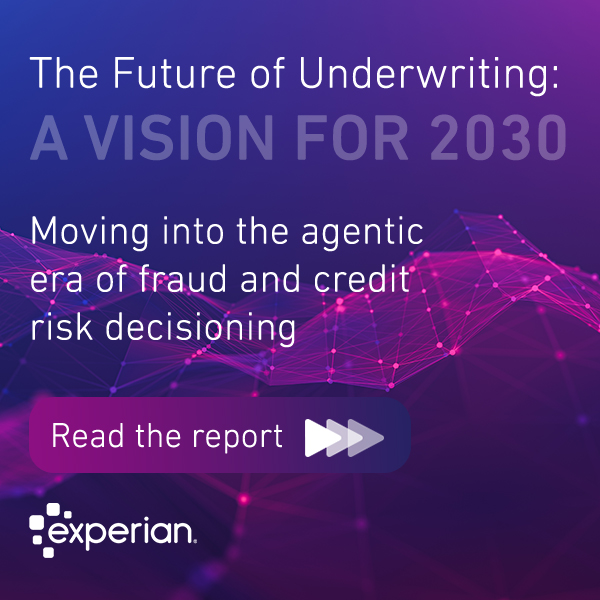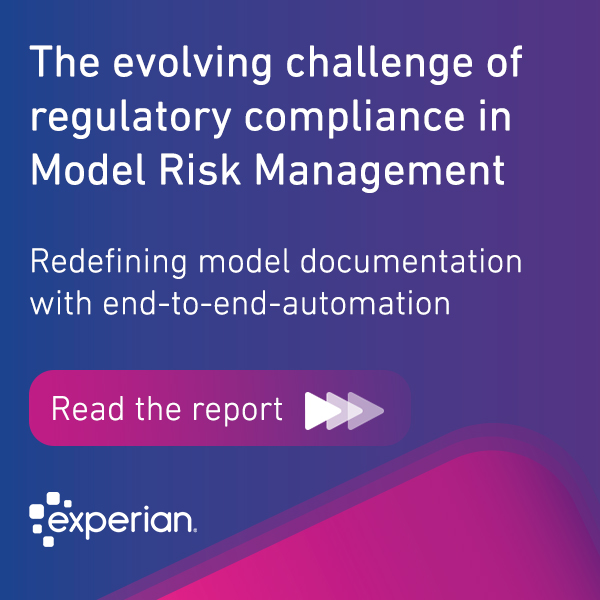Monthly Archives: November 2021

In this eSpeak podcast, eWeek’s James Maguire talks to Donna DePasquale, EVP of Global Decisioning Software, about the use of technology in financial services, and how it can satisfy the ever-increasing demand for real-time intelligence. Listen to the podcast to hear Donna DePasquale discussing: Data and decisioning challenges involved with helping financial institutions reduce risk Helping lenders make better decisions about their customers by providing simplified and streamlined services. Consumers have more choice than they’ve ever had before when it comes to credit, this, along with high expectations for their online experience, is driving businesses to invest in digital transformation and automation solutions. Growing diversity among populations in terms of spending means financial services are working to provide more personalised, real-time, meaningful experiences. Consumers want secure and convenient experiences online without compromise. Evolution of data technology Businesses can now deploy new types of analytics and new types of data services in order to serve customers. Digital transformation allows automation and insights to work together improving credit risk analysis and assessment, smoothing out the customer journey throughout the lifecycle. Access to new data types and advanced analytics. AI and analytics is not a static process, it’s a dynamic process. AI and machine learning allow for constant updates and enhancements to strategy. Future of data analytics and the credit markets Financial inclusion is a very important to the future of data analytics, especially when thinking about those growing economies around the world. We believe that all consumers deserve fair and affordable access to credit, and using alternative data sources to improve credit profiles will directly impact this. Customer experience and credit risk analysis should coexist seamlessly – asking clients to do less without sacrificing the security, convenience, relevance, and privacy of consumer experiences. Stay in the know with our latest research and insights:

How is Covid-19 impacting digital consumer behaviour and business strategy? To find out, we surveyed 12,000 companies and 3,600 businesses across 10 countries as part of a longitudinal study that started in June 2020. Watch the video for an overview of the results or download the full report. Stay in the know with our latest research and insights: This is what we discovered: Heightened consumer expectations is paving the way for digital innovation. 59% of businesses are mostly or completely recovered from the pandemic. And 47% of consumers are somewhat or completely recovered. As economic stability returns and spending resumes. Consumers are most concerned with online security and convenience. Businesses are leveraging advanced decisioning technology to simultaneously meet security and convenience expectations. Innovative decisioning technologies across fraud and credit are improving the customer experience and levelling the playing field. With 42% of consumers happy to share personal information and adoption of AI increasing significantly across businesses – from 69% in 2020 to 74% in 2021. AI, machine learning, and advanced analytics are helping businesses of all sizes to improve: Digital decisioning Credit risk management Fraud prevention and more. Digital investment has become a differentiator - in the race to improve digital customer experience there is no standing still. Those lagging behind can lose customers and opportunities. That’s why businesses across the globe are prioritising digital engagement and digital acquisition. With 76% improving analytics models and over 60% planning to increase fraud detection and credit risk analytics budgets. Since the start of the pandemic, there has been a 25% increase in digital transactions globally. Online activity and high consumer expectations are here to stay. By adopting digital solutions that separate them from the competition, businesses can thrive in 2022. Watch the video for an overview of the results or download the full report.

It’s no secret that the pandemic created a level of economic uncertainty that makes it incredibly tricky for lenders to understand their risk on a customer-by-customer basis, and therefore its impact on decision management. It’s no wonder they’re uncertain; the customers themselves are just as unsure. According to the Global Decisioning Report 2021, one out of every three consumers worldwide are still concerned about their finances even as the second anniversary of the COVID-19 outbreak approaches. While some consumers were able to easily work from home during the pandemic, others suffered job losses, cut wages, or increased expenses due to lost childcare or having to care for a loved one. As the impact of the pandemic continues to be felt – especially as government support programs begin to conclude – financial institutions will have to figure out how to navigate the uneven recovery. By leveraging advanced data and analytics, financial institutions can better understand their risk and improve their decision management. In turn, many financial institutions are creating predictive models to target their best customers and reduce exposure to unnecessary risk. However, a model is not always the end-all, be-all solution for reducing risk. Here’s why: a model requires of the right data in order to work effectively. If there isn't a data sample over a long enough time frame, the risk of creating blind spots that can leave businesses on the hook for unexpected losses can be high. Also, there will always be the need for a strategy even with a custom model. A global financial institution likely has more than enough data to create accurate, powerful custom models. However, financial institutions like local or regional credit unions or fintechs simply don't have enough customer data points to power a model. In addition, many outsourced model developers lack the specific financial industry domain expertise required to tweak their models in a way that accounts for the nuances of regulations and credit data. Finally, the pandemic continues to change the economic picture for customers by the minute, which can make a model designed for today outdated tomorrow. When a strategy makes more sense For many financial institutions, it can make more sense to focus on building out a decision management strategy instead of leveraging custom models. While a model can provide a score, it can’t tell you what to do with it. By focusing on a decision management strategy, you can leverage other information and attributes about different customer segments to inform actions and decisions. In an ideal world, of course, the choice wouldn't exist between a model and a strategy. Each has an important role to play, and each makes the work of the other more effective. However, strategy is often the smart place to start when beginning an analytics journey. The benefits of starting with strategy include: Adaptability: A strategy is much easier to change than a model. While models often have rigorous governance standards, a strategy can be adapted with relatively little compliance impact. This helps businesses adapt to changes in goals, vision, or shifts in the marketplace in a bid to attract the ideal customer. In a world that changes by the day, the ability to adjust risk tolerance on the fly is crucial. Speed: A custom model can take weeks or even months to build, test, deploy, and optimize. As a result, this can put businesses behind in analytics transformation while leaving them unnecessarily exposed to risk. On the other hand, a strategy can be developed and deployed in a relatively rapid manner, and then adapted on an ongoing basis to reflect the realities on the ground. Consistency: A strategy helps drive improvement across operations by allowing team members to ‘sing from the same songbook,’. In smaller organizations where work is still done manually by a handful of people, a strategy allows for automated processes like underwriting so businesses can scale decisioning. Strategy or model? Three questions to consider Do you need a strategy or a model? Again, in an ideal world the answer is ‘both’ due to the unique role each plays, but in the real world it depends on the institution. Here are three questions to ask in order to determine where to focus time and resources: “How different are the people I am lending to than the national average?” If the institution is lending to segments that look just like everyone else, leveraging existing third-party data sources will allow the use of generic models. In this case, the focus would be on using those generic models to power the strategy. However, for businesses that serve a niche population, a national average might skew results; in this case, it may make more sense to build a custom model. “What is my sample size?” Take a close look at the number of applications coming in each month, quarter, or year. In addition, compare it to periods dating back years to understand growth rates. This will indicate the if the data inflow required exists to power a custom model. Don’t forget to analyze how many of those applications eventually become delinquent; because some smaller financial institutions have conservative policies, they may have low delinquency rates. While this is good for the institution’s bottom line, it can make it difficult to build a model that will be able to detect future delinquencies. Therefore, even a large application sample size might not have enough variance to create an accurate custom model. “What are my long-term future goals?” This is the most difficult question to sometimes answer, as many financial institutions remain focused on navigating today’s challenges. As market conditions change, goals naturally adapt. That said, some goals might require custom models in order to effectively achieve the business vision. For example, if the plan is to enter new markets, create new partnerships, or offer new products that are different than what has been done in the past, a custom model could provide a more accurate understanding of potential risk. Our research also shows that nearly half of businesses report that they are dedicating resources to enhancing their analytics, with one-third of businesses planning on rebuilding their models from scratch. Rapid changes in consumer needs and desires means there’s less confidence in consumer risk management analytics models that are based on yesterday’s customer understanding. By focusing on a decisioning strategy, businesses can be empowered to effectively leverage analytics today to take action while creating a steppingstone for more sophisticated model-based analytics tomorrow. Stay in the know with our latest research and insights:

Businesses with priorities to acquire and retain customer loyalty should be prioritizing technology investments that improve the digital customer experience as well as prevent fraud and better manage consumer credit risk. In our latest survey of consumers globally, we found that the increase in online activity between June and October 2020 has sustained itself for the past year with little sign of digital fatigue. Consumers report that they’re online 25% more today than they were just a year ago. Many lenders and retailers have transformed their operations and met consumers’ needs for accessing goods and services online throughout the pandemic; however, customer expectations for their digital experience may be outpacing those efforts. Our same study found that customer loyalty toward businesses during the pandemic was at an all time high, but now starting to slip. 61% of consumers reported continuing to engage with the same companies they did a year ago, down 6% in twelve months. Consumers cite security, privacy, and convenience as their top priorities for engaging online. As companies adopt more digital processes and automation to deliver on the real-time financial transactions of their customers, they’re looking to access advanced capabilities for more accurate fraud prevention and credit risk management. Globally, the adoption of artificial intelligence in credit risk decisions is trending up, and 60% of businesses intend on increasing their analytics budgets. Similarly, 65% of companies are increasing their fraud prevention Scalable solutions are creating opportunities for businesses of all sizes to compete for the digital customer. What this means to a mid-size bank, credit union, building society, Fintech and neo-bank is greater accessibility to cloud-based credit risk decision management software. Decades of decisioning best practices coupled with leading edge analytics and technology can help more companies achieve their growth ambitions by attracting, acquiring, and engaging more customers. In fact, confidence in on-demand, cloud-based decisioning has grown to 81%, up from 72% in the past twelve months. Access more insights from our latest research here Other key insights: Consumers report that they are online 25% more now than they were just a year ago 42% of consumers have increased concern for the safety banking and shopping transactions 61% of consumers say they’re transacting with the same businesses, down 6% from last year Consumers rank their priorities online: security #1, privacy #2, convenience #3 Business adoption of advanced analytics has increased over last year – AI is up from 69% to 74% Confidence in on-demand, cloud-based credit risk decisioning is trending up from 72% to 81% Businesses globally say improving digital engagement and customer acquisition is their top priority 75% of consumers feel the most secure using physical biometrics #1 Digital investment is decisioning software, followed by AI and digital enablement for staff Businesses plan to increase budgets for fraud prevention (65%) and consumer credit analytics (60%) In our latest research, we surveyed 3,000 consumers and 900 businesses across Australia, Brazil, Germany, India, Italy, Japan, Singapore, Spain, United Kingdom, and United States. This report is part of a longitudinal study and published series that started in June 2020 through October 2021 exploring the major shifts in consumer behavior and business strategy throughout Covid-19. Stay in the know with our latest research and insights:

Did you miss these October business headlines? We’ve compiled the top global news stories that you need to stay in-the-know on the latest hot topics and insights from our experts. Best practices to detect and mitigate deepfake attacks David Britton, VP of Industry Solutions, writes for Search Security on how deepfake technology enables fraudsters to distort reality and commit financial crimes. Learn about how the technology works and what best practices to deploy to mitigate deepfake attacks. View deepfake infographic Consumers prefer biometrics to passwords, think less of brands with bad authentication Biometric Update looks at recent research from the CMO Council which found that a far greater number of consumers would choose to use biometrics for authentication ahead of passwords. This supports findings from the Global Identity and Fraud report from earlier this year. This article features an overview of authentication education resources for businesses to better understand where the industry is headed. Managing the Impact of Disinformation Via Deepfakes The Business Information Industry Association looks at why rapidly evolving technology platforms pave the way for even more creative approaches to fraudulent activity. With a focus on deepfakes, this piece looks at what businesses should do to minimise the impact by identifying areas of infiltration and creating a layered strategy of defence. Stories from around the world TDavivienda responde tras robo a cuentas que afectó a Jessica de La Peña CyberArk, Cybersecurity Awareness Month Stay in the know with our latest insights:




